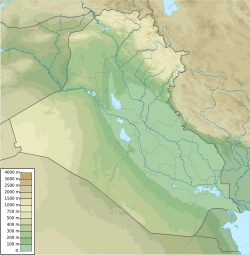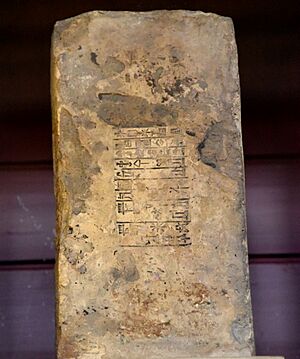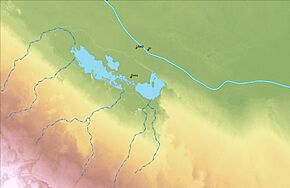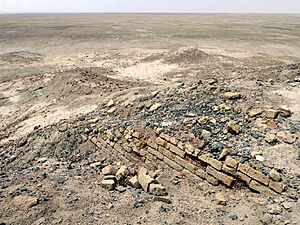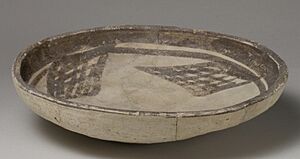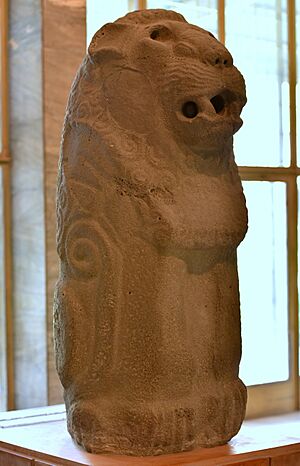Eridu facts for kids
| Location | Dhi Qar Governorate, Iraq |
|---|---|
| Region | Mesopotamia |
| Coordinates | 30°48′57″N 45°59′46″E / 30.81583°N 45.99611°E |
| Type | Settlement |
| Area | At most 10 ha (25 acres) |
| History | |
| Founded | c. 5400 BC |
| Abandoned | c. 600 BC |
| Periods | Ubaid, Early Dynastic, Ur III, Old Babylonian, Kassite, Neo-Babylonian |
| Site notes | |
| Excavation dates | 1855, 1918-1919, 1946-1949, 2018 |
| Archaeologists | John George Taylor, R. Campbell Thompson, H. R. Hall, Fuad Safar, Seton Lloyd, Franco D’Agostino |
| UNESCO World Heritage Site | |
| Official name | Tell Eridu Archaeological Site |
| Part of | Ahwar of Southern Iraq |
| Criteria | Mixed: (iii)(v)(ix)(x) |
| Inscription | 2016 (40th Session) |
| Area | 33 ha (0.13 sq mi) |
| Buffer zone | 1,069 ha (4.13 sq mi) |
Eridu (Sumerian: 𒉣𒆠, romanized: NUN.KI) was an ancient city in Sumer, a region in Mesopotamia. Today, its ruins are found at a place called Tell Abu Shahrain in Iraq, close to the modern city of Basra. Many people believe Eridu was the very first city ever built in southern Mesopotamia. It was one of many Sumerian cities that grew up around important temples.
Eridu was special because it was home to the gods Enki and his partner Damkina. Enki, who was later known as Ea, was thought to be the founder of the city. His temple was called E-Abzu, because people believed Enki lived in the Abzu. The Abzu was a special underground water source from which all life was thought to come. Another name for Enki's temple was Esira.
The people of Eridu believed their temple was very grand:
"... The temple is built with gold and lapis lazuli, Its foundation on the nether-sea (apsu) is filled in. By the river of Sippar (Euphrates) it stands. O Apsu pure place of propriety, Esira, may thy king stand within thee. ..."
Even in other cities like Ur, temples were built to honor the gods of Eridu. For example, the ruler Ur-Nammu built a temple for Ishtar of Eridu in Ur.
Contents
A City Through Time: Eridu's Long History
Eridu is one of the oldest settlements in its region. It was founded around 5400 BC during the early Ubaid period. Back then, it was very close to the Persian Gulf and the mouth of the Euphrates River. Today, it's about 90 miles (145 km) inland because the river has changed its path over thousands of years.
Archaeologists have found that Eridu was built on a fresh sand dune, meaning no one lived there before. Over time, the city grew and changed. It was continuously inhabited until about 600 BC. In its later years, it became mainly a religious site.
Early Periods: Ubaid and Uruk
During the Ubaid period, Eridu covered an area of about 12 hectares (30 acres). Archaeologists found 18 temples built one on top of another at the site. These temples were made of mudbrick. The oldest temples (Levels XIX to VI) are from the Ubaid period.
As the city developed into the Uruk period, more buildings were constructed. Finds from this time include decorative items made of terracotta and copper, and large columns. The city's population also grew, and a huge palace, 100 meters by 100 meters, was built.
Kings and Temples: Ur III and Beyond
Eridu was very important during the Third Dynasty of Ur (around 22nd to 21st century BC). Kings like Ur-Nammu built a large ziggurat (a stepped pyramid-like temple tower) over the older temples. Bricks found at the site show his name and mention his work on the temple of Enki in Eridu.
Later rulers, such as Hammurabi from the Old Babylonian period, also mentioned Eridu in their records. Hammurabi even talked about digging a canal to bring water to several cities, including Eridu. Even much later, kings like Nebuchadnezzar II from the Neo-Babylonian period built new structures in Eridu.
Exploring the Past: Archaeology at Eridu
Eridu is located on a natural hill within a large basin. This basin can become a seasonal lake during the rainy season. In ancient times, a canal connected Eridu to the Euphrates River, which was very important for the city's survival.
The site of Eridu has eight main mounds, which are like small hills covering ancient ruins. The largest mound, called Abū Šahrain, is where the main Enki Temple and the Ur III Ziggurat were located.
Archaeologists have been studying Eridu for a long time.
- The first excavations were done by John George Taylor in 1855. He found bricks with writing that helped identify the site as Eridu.
- Later, in 1918 and 1919, R. Campbell Thompson and H. R. Hall continued the work. Hall found a piece of blue glass from around 2000 BC, which was very advanced for its time.
- From 1946 to 1949, Fuad Safar and Seton Lloyd led more excavations. They found 17 layers of temples built one on top of the other, showing how the temple changed over thousands of years. They also found a cemetery with about 1000 graves from the Ubaid period.
- In recent years, new excavations have started again, with teams from Italy, France, and Iraq working together.
Stories and Legends of Eridu
In some ancient Sumerian stories, Eridu is said to be the very first city where kingship began. The Sumerian King List mentions two early kings of Eridu, Alulim and Alalngar, who ruled for incredibly long periods before a great flood.
The ancient Mesopotamians also connected Eridu to the bright star Canopus. They called it "star of the city of Eridu" because, due to Earth's tilt, Canopus was first visible from Eridu in Mesopotamia.
The Flood Myth and Adapa
An ancient tablet found in Ur tells more about how Eridu was chosen by the gods as the first city. It describes how the gods created humans and then decided to establish cities. Eridu was chosen as the first and most important city. The gods then picked Alulim to be the first king, guiding the people.
Another important figure from Eridu's legends is Adapa. He was seen as a wise man who brought civilization to the city. In some stories, he was the helper of King Alulim.
Enki and the Gifts of Civilization
In Sumerian myths, Eridu was the home of the Abzu temple, dedicated to the god Enki. Enki was the god of deep waters, wisdom, and magic. He was believed to rule over the fresh waters beneath the Earth.
Stories also tell of Inanna, the goddess of Uruk, who traveled to Eridu to receive the "gifts of civilization" from Enki. These gifts were special powers and rules that helped make a society work. Even though Enki first tried to keep these powers, he later accepted that Uruk would become a major center.
The Lament for Eridu
Ancient Mesopotamian cities sometimes had "laments" written about them when they fell or were destroyed. These poems described the sadness and ruin. The Lament for Eridu describes the city's downfall:
"Its king stayed outside his city as if it were an alien city. He wept bitter tears. Father Enki stayed outside his city as if it were an alien city. He wept bitter tears. For the sake of his harmed city, he wept bitter tears. Its lady, like a flying bird, left her city. The mother of E-maḫ, holy Damgalnuna, left her city. The divine powers of the city of holiest divine powers were overturned. The divine powers of the rites of the greatest divine powers were altered. In Eridug everything was reduced to ruin, was wrought with confusion."
City Design: Eridu's Architecture
The most important part of Eridu was Enki's temple, called the House of the Aquifer (E-Abzu). This name refers to Enki's connection to water. Later, it was also called the House of the Waters. Enki's partner, Ninhursag, also had a temple nearby.
During the Ur III period, King Ur-Nammu built a large ziggurat on top of the older temple ruins. Many later kings also worked on or repaired the E-Abzu temple, showing its lasting importance.
House of the Aquifer (E-Abzu) Temple Levels
Archaeologists have found many layers of the E-Abzu temple, showing how it was rebuilt and changed over thousands of years. Each level represents a different period of construction.
| Level | Date (BC) | Period | Size (m) | Note |
|---|---|---|---|---|
| XVIII | 5300 | - | 3×0.3 | Smallest beginnings |
| XVII | 5300–5000 | - | 2.8×2.8 | First main room |
| XVI | 5300–4500 | Early Ubaid | 3.5×3.5 | |
| XV | 5000–4500 | Early Ubaid | 7.3×8.4 | |
| XI | 4500–4000 | Ubaid | 4.5×12.6 | First raised platform |
| VIII | 4500–4000 | Ubaid | 18×11 | |
| VII | 4000–3800 | Ubaid | 17×12 | |
| VI | 4000–3800 | Ubaid | 22×9 | |
| V | 3800–3500 | Early Uruk | - | Only platform remains |
| I | 3200 | Early Uruk | - | Only platform remains |
See also
- Abzu
- Cities of the Ancient Near East
- Lake Hammar
- Tepe Gawra


